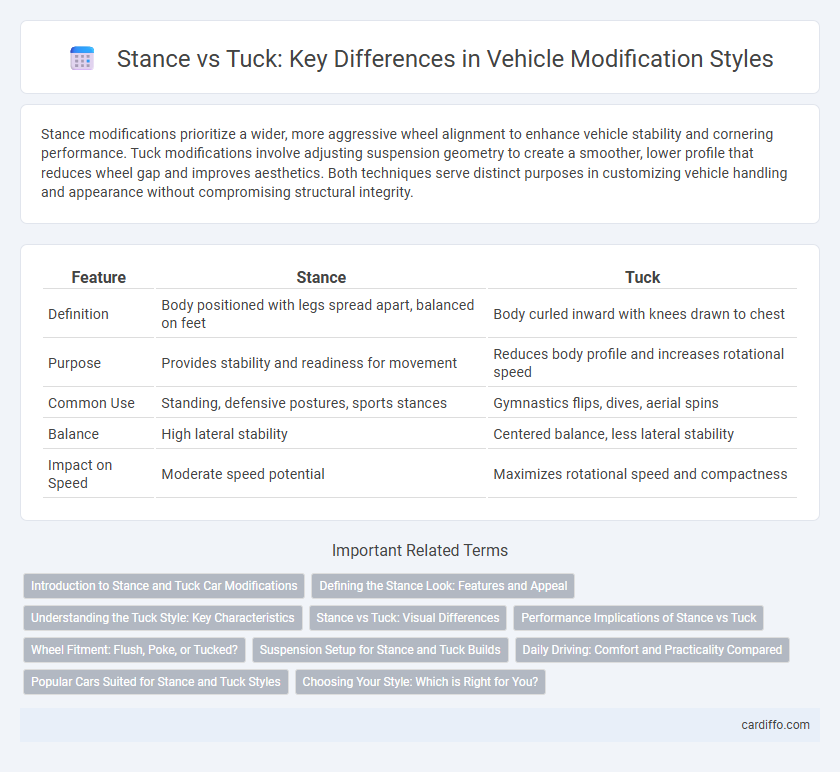Stance modifications prioritize a wider, more aggressive wheel alignment to enhance vehicle stability and cornering performance. Tuck modifications involve adjusting suspension geometry to create a smoother, lower profile that reduces wheel gap and improves aesthetics. Both techniques serve distinct purposes in customizing vehicle handling and appearance without compromising structural integrity.
Table of Comparison
| Feature | Stance | Tuck |
|---|---|---|
| Definition | Body positioned with legs spread apart, balanced on feet | Body curled inward with knees drawn to chest |
| Purpose | Provides stability and readiness for movement | Reduces body profile and increases rotational speed |
| Common Use | Standing, defensive postures, sports stances | Gymnastics flips, dives, aerial spins |
| Balance | High lateral stability | Centered balance, less lateral stability |
| Impact on Speed | Moderate speed potential | Maximizes rotational speed and compactness |
Introduction to Stance and Tuck Car Modifications
Stance and tuck modifications significantly alter a car's aesthetic and performance by adjusting wheel alignment and suspension settings. Stance typically involves lowering the vehicle and increasing negative camber for a wide, aggressive look, while tuck focuses on fitting the tires closer to the fender for a cleaner, streamlined appearance. Understanding these modifications enhances customization choices for car enthusiasts seeking both visual appeal and functional improvements.
Defining the Stance Look: Features and Appeal
The stance look is defined by a lowered suspension, aggressive wheel fitment, and stretched tires, creating a visually striking, flush appearance with the fenders. Its appeal lies in balancing aesthetics with driving dynamics, emphasizing style without compromising performance. Unlike tuck, which focuses primarily on concealing wheel gaps by tucking tires into the wheel wells, stance highlights bold, wide wheels and lowered ride height for a distinctive street presence.
Understanding the Tuck Style: Key Characteristics
Understanding the tuck style involves recognizing its unique positioning where the rider's elbows and knees remain close to the body, reducing aerodynamic drag significantly. This posture enhances speed by minimizing frontal area and allowing for better control during high-velocity descents. The tuck differs distinctly from the stance style, which prioritizes stability and maneuverability over aerodynamic efficiency.
Stance vs Tuck: Visual Differences
Stance and tuck positions exhibit distinct visual differences primarily in body posture and leg placement. Stance involves feet flat on the surface and a more upright torso, while tuck features bent knees and a forward-leaning upper body, creating a compact silhouette. These differences optimize balance and aerodynamics depending on the activity, such as skateboarding or skiing.
Performance Implications of Stance vs Tuck
Stance and tuck positions significantly impact aerodynamic efficiency and overall performance in cycling and speed skating, with tuck typically reducing frontal area and drag for faster speeds. Maintaining a tuck position increases muscular demand and may limit power output sustainability, whereas a stance allows better power generation and endurance. Optimizing between stance stability and tuck aerodynamics is critical for balancing speed and energy conservation during competition.
Wheel Fitment: Flush, Poke, or Tucked?
Wheel fitment plays a crucial role in defining a car's stance, with flush wheels aligning perfectly with the fender for a sleek appearance. Poke fitment extends the wheels beyond the fender line, creating an aggressive and bold look while potentially affecting handling and legal compliance. Tucked fitment involves wheels sitting well inside the fender, often used in modified cars with lowered suspensions for a clean, subtle aesthetic but may compromise tire clearance.
Suspension Setup for Stance and Tuck Builds
Suspension setups differ significantly between stance and tuck builds, with stance builds favoring softer springs and higher damping to enhance comfort and body control during cornering. Tuck builds require stiffer springs and firmer damping to maintain aerodynamic stability and reduce chassis roll at high speeds. Optimizing suspension geometry in both builds ensures maximal grip and predictable handling tailored to their distinct dynamic goals.
Daily Driving: Comfort and Practicality Compared
Stance and tuck modifications both impact daily driving comfort and practicality, with stance prioritizing aesthetics through lowered suspension and stretched tires that may reduce ride quality and tire longevity. Tuck, involving folding the tire sidewall under the fender, maintains more suspension travel and often results in a smoother ride and better tire protection for everyday use. For daily driving, tuck provides a balance between aggressive appearance and functional comfort, while stance modifications can compromise practicality due to increased risk of tire wear and harsher suspension feel.
Popular Cars Suited for Stance and Tuck Styles
Popular cars suited for the stance style include the Volkswagen Golf Mk7, Nissan 240SX, and Subaru WRX, known for their aggressive fitment and lowered suspension. For tuck style enthusiasts, the Mazda MX-5 Miata and Honda Civic are favored due to their ability to accommodate extreme tire tuck without sacrificing handling. Both styles emphasize aesthetics and performance, making these models ideal for enthusiasts seeking customization in modification culture.
Choosing Your Style: Which is Right for You?
Choosing between stance and tuck modifications depends on your specific needs and riding style. Stance offers greater stability and comfort for freestyle or cruising, while tuck provides enhanced aerodynamics and speed for racing or downhill. Consider factors such as terrain, speed goals, and body mechanics to determine which style optimally enhances your performance and control.
stance vs tuck Infographic

 cardiffo.com
cardiffo.com